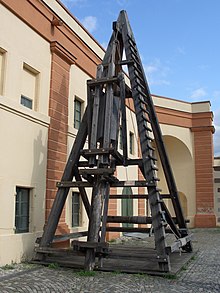Caesar's Rhine bridges



Caesar's bridges across the Rhine, the first two
Background
During
While he could have crossed the river by boats which the Ubians had offered to provide, Caesar decided to build a bridge to demonstrate Rome's ability to bring the fight at any time to the Germanic tribes. Additionally, as he indicated in his Commentary on the Gallic War, this approach conformed more to his own dignity and style.
Construction

The first bridge
Caesar's first bridge was most likely built between
The construction of this bridge showed that Caesar, and Rome, could go anywhere, if only for a few days. Since he had over 40,000 soldiers at his disposal, they built the first bridge in only 10 days using local lumber. He crossed with his troops over to the eastern site and burned some villages but found that the
The second bridge
Two years later Caesar built a second bridge near the site of the first one, possibly at today's Urmitz (near Neuwied). He built the bridge "in a few days", as described in Book 6 (Liber VI). His expeditionary forces raided the countryside, but did not encounter significant opposition as the Suebi retreated. Upon Caesar's return to Gaul, the bridge was taken down.
Results
Caesar's strategy was effective, as he was able to secure the eastern border of Gaul. He demonstrated that Roman power could easily and at will cross the Rhine and henceforth for several centuries significant Germanic incursions across the Rhine were halted. Further, his feat served him in establishing his fame at home.
With Roman colonization of the Rhine valley more permanent bridges were built later at Castra Vetera (
Controversies about the location
Speculation about the location of the bridges is due to the temporary nature of the construction and the lack of a precise location in Caesar's report. However, diggings in the Andernach-Neuwied area found residual pilings that are considered to be remnants of Caesar's bridges. As an alternative site a place south of Bonn has been mentioned.[1]
See also
References
- ^ a b c B.Nebel. "Julius Cäsars Brücke über den Rhein" (in German). Retrieved 2006-09-13.
- ^ A.Voggenreiter. "Historischer Rückblick" (in German). Archived from the original on 2006-10-16. Retrieved 2006-09-13.
Further reading
- Caesar's De Bello Gallico (English translation)
- O'Connor, Colin (1994). Roman Bridges. Cambridge Univ. Press. ISBN 0-521-39326-4.

